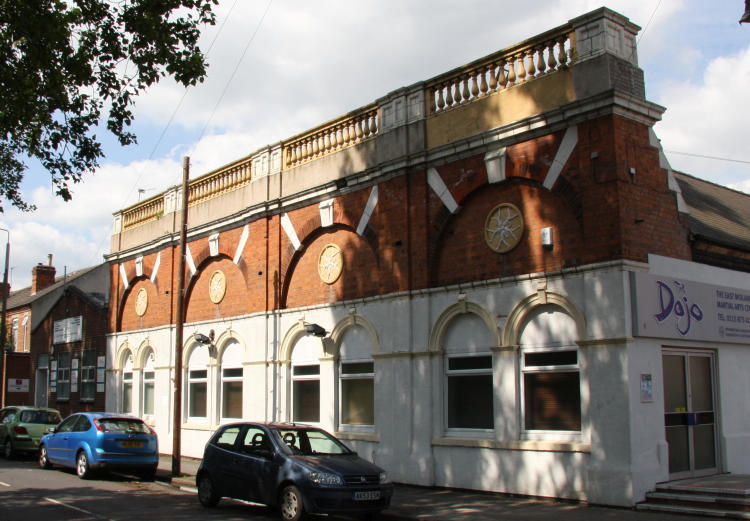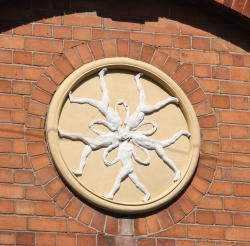|
|
| Home Topics Memorials Miscellany Transcripts References Family History Glossary Latest Beeston Blog About us | Site Search |
|
The Humber Company - Cycles and More
This image of the Humber factory is dated 1898 and shows the amazing size of the Humber factory that had been built on its Beeston site, after vary small beginnings, over just twenty years. The larger road, in the foreground, is what is now Queens Road, while the narrower road on the left, is what is now known as Humber Road. The entrance to the offices, as well as a wider entrance to the factory itself, appear to be visible there, As the image is a drawing, rather than a photograph, it may be subject to some artistic licence although its outline on the contemporary map and photographs that survive and shown below, appear to confirm its impressive size 1 -
These photographs, probably dating from the first few years of the 20th century, show the impressive size and extent of the Humber Road frontage of the factory that then faced what was then open land, apparently in use as allotments, that is now the site of Queens Drive. On the left of the tinted photograph, can be seen a lower, separate wing that was probably adminstrative accomodation that is clearly the building that still survives on Humber Road with the Humber roundels (see photograph at the end of this page).
The clock and bell tower that are featured in the story of the 1936 fire that appears later on this page, can be seen in the central factory bay. The map, also dated from about 1900, again confirms the impressive extent of the factory. The cricket ground is believed to be associated with the factory. The extension to Queens Road that passes the factory is then shown as Albert Road but has since been renamed and extended as Queens Road East, bye-passing Hassock Lane. The 'Albert Road' name was then reused between Broadgate and Lower Road. Workers' housing can be seen, established in the streets to the north of the factory, off of Humber Road. What is now Fletcher Road, is then shown as Humber Grove. Thomas Humber who is at the centre of this story. is widely accepted as being a leading pioneer of the cycle industry (Shown left in his elder years). He was the eldest son, the third of eight children of Samuel Humber, a tailor, and his wife Lucy (née Turton). He was born in October 1841, in Sheffield 2, where his parents had moved to shortly before, although Samuel, his father, had his roots in Nottingham and Lucy in Heanor, Derbyshire 4, where they were born and they had married at St Leodegarius Church in Basford, Nottingham in December 1834 5.
Thomas continued to find work and built his experience, with his fondness for reading and his enquiring and logical mind serving him well. With this growing confidence and experience, he went on to work in the Derbyshire and Nottingham areas for several grateful employers such that, he later claimed that he was soon earning 8 to 9 a week even then. One of his employers, while still in his very early twenties, was the Alfreton firm, The Butterley Company, which was very impressed by his devising a more efficient method of building deck beams for Royal Navy ships. In Nottingham he was employed by a number of firms making and maintaining textile machinery - probably including lace making machines and often in the Radford district - just like his grandfather had done when he had moved there to live and found work with small engineering firms that were then opening up to serve the early years of the lace trade. By 1863, Thomas had met Emma Elizabeth Freeman, the daughter of William Freeman, a tailor as was Thomas's father, and his wife Emma (née Clifford). Both families lived in nearby streets, East Street and Broad Street in the Hockley area of central Nottingham and Emma was working as a lace mender. The couple went on to marry at St Peters Church, Nottingham on 7th April 1863. They were to have two children - a daughter, Emma Eliza was born in 1864 and their son, William Francis, was born in 1866. A few years later, by 1867, Thomas was working for the engineering firm of Manlove & Elliott which made industrial machines at its factory on Ilkeston Road, Radford, Nottingham. While working there, but with the benefit of an agreed weeks break, he carried out some much-appreciated work for Reuben Reader, a Nottingham textile machine builder and mechanic 15. However, his employer was not pleased when they heard and suspended him from his job. Not prepared to accept this, Thomas resigned and turned to Reader who offered him three days a week work and loaned him some tools. It was a change of direction that was to change Thomas's life.
During these exciting years the range of bicycle designs that were devised by Thomas continued to increase, all receiving the attention to detail that he insisted on and never deviated from, such that the reliability of his products arose from his high standards and emphasis on quality. It became the basis of the Humber becoming regarded as the aristocrat among cycles and was to be its overwhelming selling-point. Shown below are some of cycles produced at Beeston over its first twenty years:
In 1885 the partnership was dissolved with, remarkably, Marriott & Cooper retaining the equal right to use the name 'Humber' and to use any of the old company's patents in their products. Not surprisingly, they promptly set up a rival operation, distributing cycles made for them by Rudge and using that 'Humber' name. As a result, Thomas began advertising his cycles as Genuine Humber and attempted to register this as their trade mark, but this was successfully resisted by Cooper & Marriott. For his part, Thomas entered into partnership with another keen cyclist friend, Thomas Harrison Lambert, then aged about 27, the son of the Nottingham hosiery manufacturer. He had also begun to build a reputation as a company promoter and, in 1887. the partners agreed to sell the company to a group of speculators, William and Joseph Horton, Edward Alfred Hicks and Christopher Norris Baker. In turn, this group floated a company which they named Humber & Company Limited which, as well as Humber's Beeston works - where 350 were then employed - it also included the Express Cycle Works in Wolverhampton, Wellington Works in Coventry and the Coventry Cycle Works. The company was to use the Humber name in recognition of the public's perception of the quality and reliability of that company's products, even though it was not the largest of the four units involved. Thomas Humber agreed to act as General Manager for five years and he did indeed retire in 1892 with Martin Diederich Rucker then appointed as General Manager. Rucker was born in Stoke Newington in 1855, the son of Martin Diederich Rucker, Senior (1819-1884), a shipping and insurance agent and his wife, Mary (née Wilton). In 1880, he married Emmie Nicholls and began to trade as a cycle agent. In 1882, his company, M D Rucker and Company, had BSA make 65 tricycles - in a design that he gave the name "The Rucker" - but within two years he was declared bankrupt. Later he was introduced to Humber by T Harrison Lambert and became the manager of the company's Holborn Viaduct branch. After Thomas Humber retired in 1892, Rucker became Humber's General Manager and soon became involved with the notorious company promoter, Ernest Terrah Hooley and, together, they created subsidiary companies in France, USA, Portugal. Denmark, Sweden and Russia. Then, in 1896, the wholesale and retail departments of the business, along with the goodwill of Marriott & Cooper, were transferred to yet another new entity, The Humber Extension Company. This was soon exposed as a inflated scheme and Rucker and other directors that had been involved were dismissed. After a several boom years in the early 1890s the company hit financial difficulties in the slump that followed in 1898-1899 and, in 1898, E Terrah Hooley was made bankrupt and Humber closed down its overseas companies. The Humber & Co Limited, together with the goodwill of Marriott & Cooper were transferred to a new company named "Humber Limited" and a new start was made under the overall management of Edward Powell. Happily, at the company's AGM in November 1901, he was able to report that, at least for the moment, many of the issues that had arisen had been resolved and the company was in a position to pay a dividend. When Thomas had moved to Beeston in 1878, it appears that his wife, Emma Elizabeth. and family did not follow and she was later to accuse him of misconduct, over several years, starting in 1874. By 1881, she was living with their two children, Emma Eliza and William Francis, on Arkwright Street, Nottingham while Thomas was living on Queens Road, Beeston, near to the factory, with his parents living nearby. In 1886, his wife sued for divorce which he contested and it was dismissed, apparently after a financial settlement but they were to continue to live apart for the rest of her life. By 1891, he had moved to live at 10 Broadgate, Beeston with 'Nellie' Robinson, described as a servant. His wife and daughter were then living at 128 London Road, Nottingham with their daughter, both, apparently, well provided for. After his retirement from Humber, Thomas moved to live in Hampton, Upper Teddington, Middlesex with Eleanor Robinson, 30 years younger, described as his wife. His actual wife and daughter were then living on Gedling Road, Carlton, Nottingham and Emma Elizabeth was still living there at the time of her death in August 1903. Thomas and Eleanor married, about a month later, on 9th September 1903 at St John the Evangelist, Kensal Green. They then moved to live in a beautiful house, Villa d`Arno, Albany Park, Kingston-on-Thames, Middlesex. He died there on 2 November 1910, aged 69. His son having died in 1909, Thomas's estate, valued at 20,546, was proved by his solicitor together with Frederick Charles Bush, a trusted colleague in the cycle industry who went on to be a Director and General Manager of The Raleigh Cycle Company and his daughter, who never married but was able to life a comfortable life, keeping close to her brother's widow and family, until her death in February 1947, aged 83. She left 11,236 4s 8d.
After Thomas Humber's retirement in 1892, the Beeston factory continued to produce the company's high-end bicycles while more basic versions were made at the Coventry and Wolverhampton factories. Alongside this, these sites also took part in the response to the rise in motorised vehicles that, perhaps enevitably, had begun to emerge, particulary in France. By 1896, they had fitted a small engine to a bicycle frame and it was from that time on that Beeston folk became used to the sight of these and a succesion of motorised vehicles of increasing sophistication being driven along Queens Road, under test. In the event, production of motorised bicycles was soon dropped for lack of space in the factory but by 1899, a motor tricycle (see above left) was being produced in Beeston. In 1901, the French designer, Louis Harvé Coatalen was recruited by Humber and also in that year came the first Beeston Humber car (see above centre), a design that was of a design that differed from and was of a higher quality than those being produced at the other factories and was therefore aimed at the higher end of the market. In 1904, Coatalen recruited Thomas Charles Pullinger (c1867-1945), from Sunbeam, to manage the Beeston factory and higher specification car production continued there, including models with space for a chauffeur, a 4-speed gearbox and the continuing provision of the characteristic single-spoke steering wheel(see above right) Then, in September 1908, after weeks of speculation, confirmation was made-known of the intention to consolidate manufacturing of cycles and cars in a new factory that had been built at Stoke, on the outskirts of Coventry. It would take in the company s existing Coventry factory as well as its whole Beeston operation as part of a cost-saving programme. The move was completed by early in October 1908 and the Beeston factory then stood dormant. In November, what remained of the contents were sold off by public auction leaving an empty building. This picture appears to show the then, somewhat forlorn, Humber Road frontage of the factory in this era.  For Beeston, in the short to medium term at least, it was a disaster, both in employment terms and in the many houses that became empty when many of the skilled workforce moved to Coventry. Not all had been resident in Beeston but, of course, many of them were. Nevertheless, some accounts record that, including their families, some 3000 Beeston residents made the move, leaving some 600 empty houses. Yet another financial reconstruction of the company followed. For Beeston folk who remained, the hope remained that a new use could be found for the factory. A New Beginning for the Site - In fact, happily, they did not have to wait long for a very acceptable solution when, on 28 February 1909 at the George Hotel in Nottingham, the factory, standing on a four-acre site, was sold at auction. Bidding started at 6,000 and it was knocked down for 11,000 to the well-established and successful Nottingham lace manufacturer, politician and philanthropist, Arthur William Black. The story of his large-scale plain net making operation on this site has already been told when we set out the story of lace making in Beeston. It can be seen HERE. And, although Black s own lace making firm was excellent in itself, it was to take up only part of the available space with the remainder soon occupied by other companies see below - offering jobs. It was later, in fact, a double win for Beeston as it not only offered employment generally but some relief for the lace making industry in particular that it was otherwise to suffer over the next decade. So it was that, within months, the previously derelict site was occupied and in full operation again. Alongside Black s own operation, and no doubt encouraged by his reputation and connections, he was joined by a number of other lace making firms and a few other trades. By 1914 when War was declared Black s firm was already engaged on a large scale in making plain net, on 40 machines as well as some Levers lace and much of the remainder of the factory was occupied by others, including:
The 1917 Fire - The first of two large fires that were to destroy the factory as it was, started just before 10pm on Thursday, 19 April 1917, and discovered by workers of the shift that would end at midnight, with Willia & Co, on the upper floor facing what is now Queens Road. The section on the floor below was empty, having been vacated by the firm of Collingham & Owen some two months earlier. The fire was soon well alight, the lantern roof fell-in within an hour and the building was to remain alight throughout the night. It soon attracted many onlookers and, given that the country was at war, and the flames could be seen got miles around, there was much concern that it would attract an airship attack. Although the local fire brigade, with its relatively new, horse-drawn, steam-powered Merryweather fire engine (SEE HERE) was quickly on the scene, it was soon apparent that the size of the fire would be a challenge for them. Sir Edward Black and Ernest Jardine, who had arrived on the scene very soon after it started, made calls for help from both Nottingham and Long Eaton brigades but, in both cases, were told that they were not permitted to leave their own area. Happily, after a long period plying their hoses, they were able to confine the major damage to the single wing of the building. While it was still smouldering the next day and the hoses were still in use, it was then under control. Sir Edward Black later wrote to thank the members of the Beeston brigade for their efforts. Sadly though, the piles of debris and smashed machinery said to include some 200 lace machines were sad indications of the losses that had been incurred by some of the tenants, largely those in the affected wing. These included Bates and Young with (insured) losses of about 10,000, Willia & Co which had been in the heart of the fire, and Ford, Whitehead Ltd which had looses estimated at 250,000 although another section of its business on the site was largely untouched. After the Fire - with the energy of those involved and the ever-present continuing needs and demands of the war, the undamaged sections of the factory were soon back in production. Parts of the damaged wing, however stood as a reminder of the tragedy (see below) and were never fully restored and its tenants never returned. 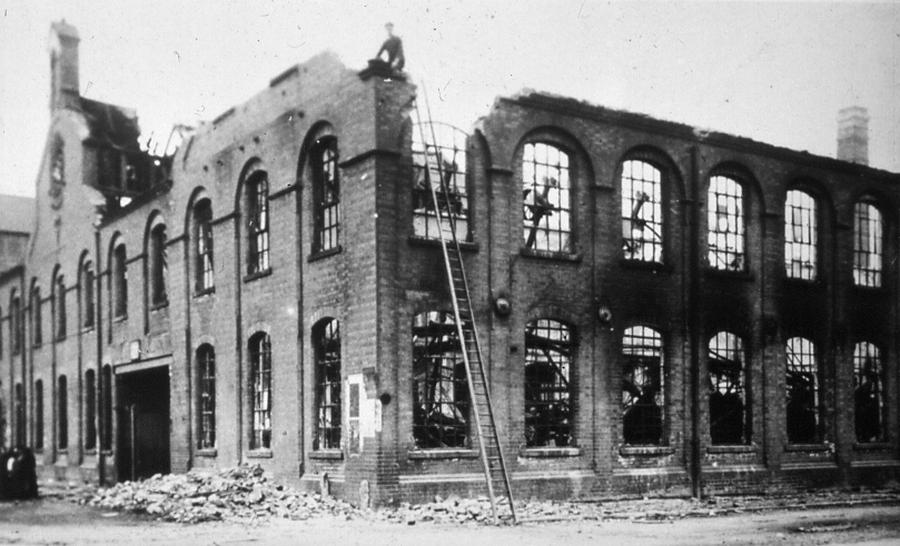 However, in the years following the war, the lace industry was clearly in decline and Beeston had already focused on the engineering companies notably Beeston Foundry and Ericssons as its more likely future. Happily though, a relatively good demand for plain net remained and Blacks continued to operate in the surviving parts of the factory. In 1920, they were working 32 plain net machines including six new giant machines, each 274 inches wide. For the time being, the Leivers lace manufacturer William N Turner also persevered but, for the most part, the remaining parts of the factory increasingly began to depend on a variety of new tenants which included the card punchers, John Adcock & Sons, Coopers of Beeston Limited, the Jacquard loom card manufacturers that had been founded by Thomas Wilson Cleveland in 1934, the Swiss embroidery firm run by Lionel Disney, the lace curtain manufacturer, Charles King, which became Harris King & Company after Charles death in 1934 and the lace maker John Perry.
But true diversity came, certainly by the early 1930s, when the long-standing firm of Nottingham boiled sweets, nougat and chocolates manufacturers, J H Jackson Limited, opened a production unit on the top floor of one of the factory wings, above a unit used by A W Black to store unused machines. The company had been formed around the turn of the century by John Henry Jackson who was born in Thirsk, Yorkshire in about 1858, the son of William, a bricklayer, and his wife Mary. He went on to train as a grocer and, in 1996, married Mary Ann Lewis, the daughter of a grocer and farmer and his wife Mary, from Winscombe, Somerset. By 1891 they were living on Loughborough Road, West Bridgford and were already operating the business. Three daughters and a son were born to the couple but, tragically, their son, Lewis Henry, was killed at the Battle of Neuve Chapelle on 13 March 1915. After having begun to work for the family business, he had volunteered with the Sherwood Foresters as early as September 1914 and had been in France for only about a week when he was killed. By 1899 Jackson was trading from premises at 4 Wilford Street, Nottingham and, by 1905, he was operating from a factory on Canal Street, Nottingham. John Henry died in October 1936 and the confectionery business was acquired by Stanley William Hadley and his father William Joseph Hadley who had then initiated the move to Beeston. The 1936 Fire - At about 7pm on Friday, 24th April 1936, fire struck the factory once more, this time it was centred on the next of the original bays in premises on the top floor, occupied by the sweet makers, J H Jackson Limited who had moved in there just
a few months before. It wasn t long before employees around the site, many of them on the move at the end of their shift, noticed smoke coming from the chimney, alerted their colleagues and began to move what items they could from nearby workshops. This intervention
by employees both those working there when fire broke out and others that returned when they heard what was happening, was to help much of the contents that would have otherwise been lost. Beeston fire brigade, now with more up-to-date equipment two appliances -
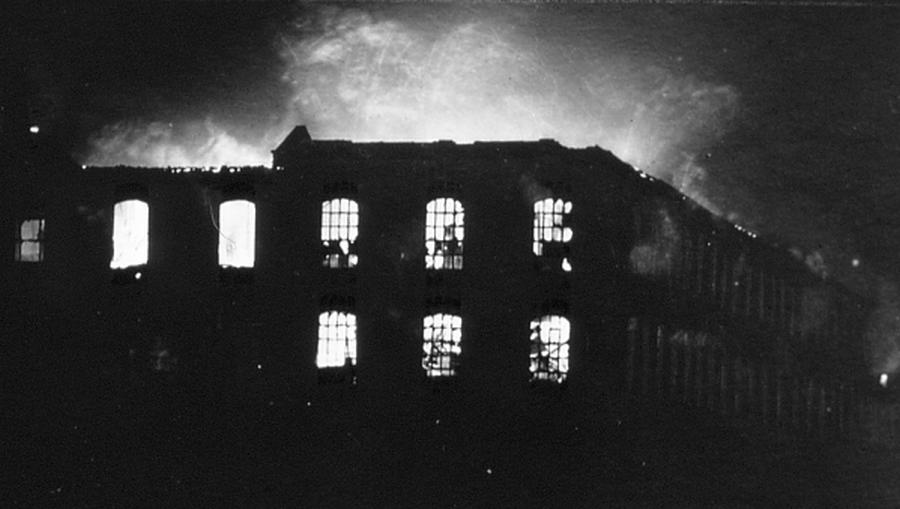
On arrival, the fire brigade, under Chief-Officer Kilby, had been immediately confronted with a sizeable task and did not hesitate to call for assistance from Stapleford which was able to send another engine and trailer. A call for assistance from the City was, at first, refused by Captain Athelstan Popkess, the Chief Constable who was also then responsible for the City Fire Service but he then agreed to the deployment of two appliances, after an intervention by the Lord Mayor, Sir Albert Ball - who was also a Director of Blacks - and they arrived on the scene at 9.15 and remained on site until 11.30pm. But from the start, all those fighting the fire faced the difficult problem and frustration - of low water pressure which meant that the number of hoses in use was often limited such that some were often seen with inadequate water delivery or even, at times, none at all and it was believed that the losses - part of which are shown right - were greater as a result. The local fire appliances were to stay on site overnight - but not without difficulties when the big-end failed on two engine pumps. It had been a difficult time which, thankfully, was finally under control by the next morning but with losses estimated at 25,000. The issues of the reliance on the City brigade and the inadequate water pressure, were continued to be argued and discussed by the Councils in the months that followed.And Then - having suffered two ownerships and two fires over its then 58-year history, the site was now unrecognisable from what it had been before the fires, and this was to continue to be the case as the ruins were cleared up or refashioned into usable workspaces. The six years of war and the period of austerity that followed, left little latitude to focus on improving the site although Sir William Black s lace making operation did continue up to his death and beyond, having been taken over by the Jardine Group and, in 1952, it is said that there were 118 machines operating there and was then the largest plain undertaking in the UK. This was a position which, in the face of the general decline in the industry, locally as well as nationally, was not to last and there is now no trace of what had been a major enterprise - as is not quite the case with Humber, its predecessor on the site, as a feature on a surviving section of the Humber Road frontage proudly displays that company's roundel trademark and, across the original site can be seen traces of the original factury, adapted for use by today's businesses. It is, indeed, a site that has lots of stories to tell.
Notes
© David Hallam - 2024 |
|
||||||||||||||||||||||||
|
|
||||||||||||||||||||||||||
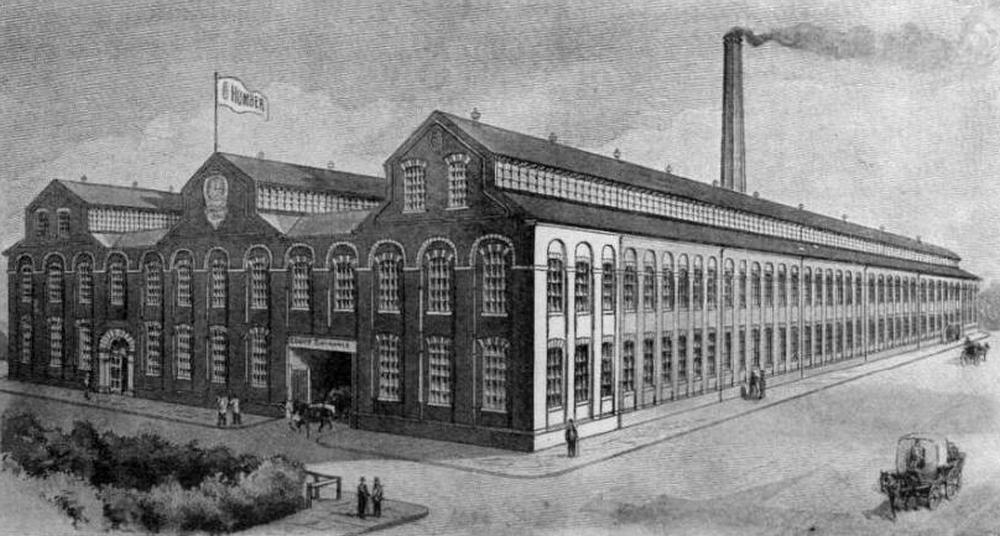
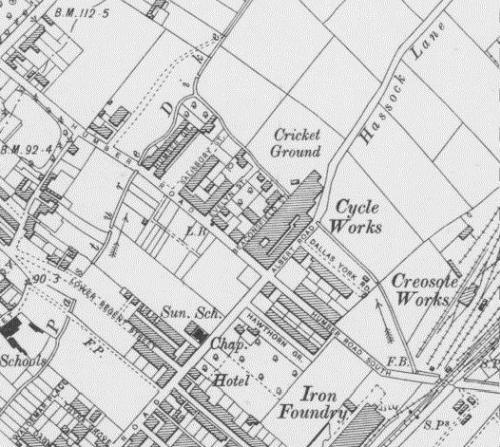
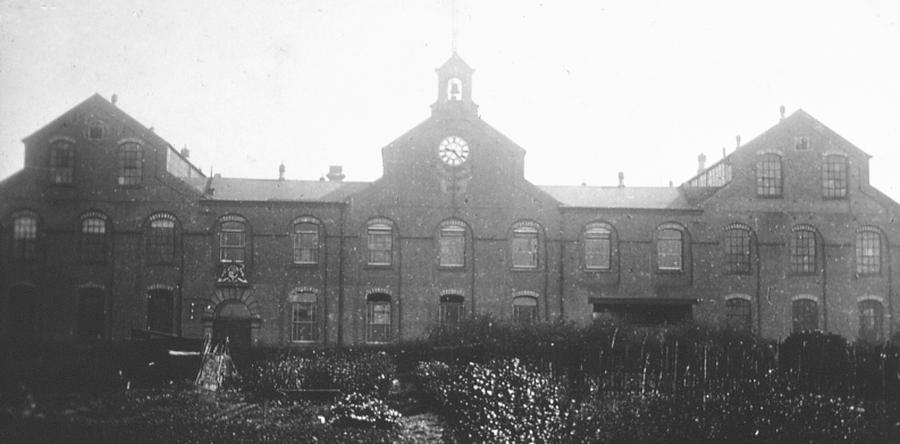
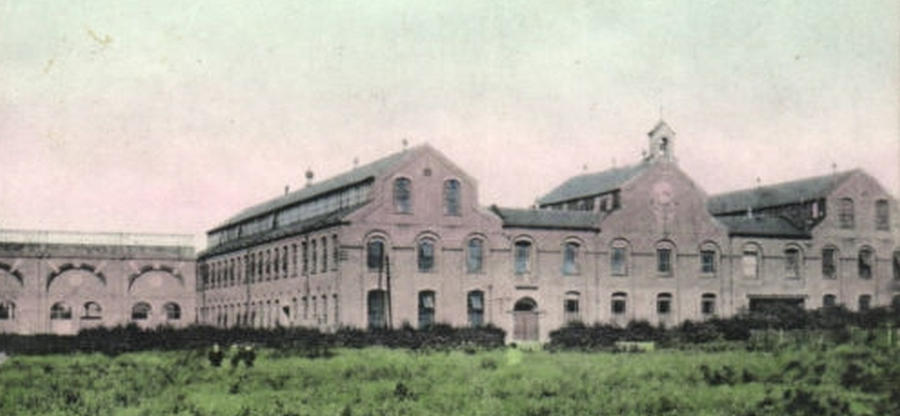
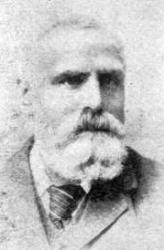 In 1848, when Thomas was aged about seven, Samuel, with his wife and family, moved to Hull
In 1848, when Thomas was aged about seven, Samuel, with his wife and family, moved to Hull 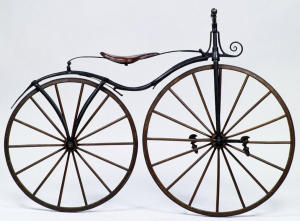 So it was that, in 1868, using these basic resources, the contacts he had made and the confidence he had built up as a practical engineer, he went on to set up a small workshop, working for himself as a blacksmith, in a
shed in his back yard, believed to be at 65 Northumberland Street in the St Anns district of Nottingham. And, it wasn't long before his enquiring mind discovered something the interested him and appeared to
offer opportunities. He had spotted a story about the Pierre and Ernest Michaux's velocipede, probably the first pedal-assisted dandy-horse, that had appeared in 'The English Mechanic' and he had already seen one that had been brought from Paris by
William Campion. It was a simple bicycle with a cast-iron frame, pedals acting directly on the front wheel and a hand-operated lever brake (Shown Right). After studying it carefully. Thomas was confident that he could
improve on its design detail and produce something that would have wide appeal. He then set about producing an improved version in his small workshop, followed, early in 1869, by a second with even more improvements. These were the first
bicycles produced in the United Kingdom and found an interested public but not one that was immediately willing or, indeed, able to spend the money that was involved. At the time, Thomas had been doing work for William
Campion, the Nottingham-based sewing machine maker and Thomas attempted to interest him in getting involved but was unable to convince him
So it was that, in 1868, using these basic resources, the contacts he had made and the confidence he had built up as a practical engineer, he went on to set up a small workshop, working for himself as a blacksmith, in a
shed in his back yard, believed to be at 65 Northumberland Street in the St Anns district of Nottingham. And, it wasn't long before his enquiring mind discovered something the interested him and appeared to
offer opportunities. He had spotted a story about the Pierre and Ernest Michaux's velocipede, probably the first pedal-assisted dandy-horse, that had appeared in 'The English Mechanic' and he had already seen one that had been brought from Paris by
William Campion. It was a simple bicycle with a cast-iron frame, pedals acting directly on the front wheel and a hand-operated lever brake (Shown Right). After studying it carefully. Thomas was confident that he could
improve on its design detail and produce something that would have wide appeal. He then set about producing an improved version in his small workshop, followed, early in 1869, by a second with even more improvements. These were the first
bicycles produced in the United Kingdom and found an interested public but not one that was immediately willing or, indeed, able to spend the money that was involved. At the time, Thomas had been doing work for William
Campion, the Nottingham-based sewing machine maker and Thomas attempted to interest him in getting involved but was unable to convince him 
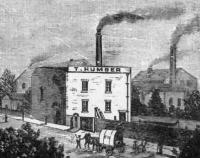 By 1871/2 Thomas bicycle designs had advanced to his 'Spider Bicycle', an early form of the 'Ordinary' - widely known as the 'Penny-Farthing' - with a large front wheel and a trailing small rear wheel. This soon became popular locally and
amongst those in the cycling world but to become a commercial success, the bicycle needed to be made in volume and to be properly marketed. As progressions in that direction, he moved to bigger premises at 29a Streeton Street, Union Road - still in the St Anns
area of Nottingham - and, in 1874, he issued his first price list (See Left). In 1875, he moved his workshop to Queens Road, near the station in Nottingham. But it soon became obvious that, given Thomas's main focus on design and the
development of his ideas, running a growing business was not something that he could do on his own. Thomas Rushforth Marriott, born in 1850, the son of a Fiskerton, Nottinghamshire miller, employing four men, Joseph Marriott and his wife
Anne (n#233;e Shepherd). By 1877, he had become well acquainted with Thomas and was a well-known cyclist. the Captain of the Nottingham Tricycle Club and an enthusiastic rider of Humber bikes. Now he joined Thomas in partnership, as 'Humber &
Marriott' to help take the business forward. In 1877, they were joined by Fred Cooper, another champion cyclist, born in 1852 in Clerkenwell, London, the son of Joseph and Eleanor Cooper. By the 1870s he had been living in Sheffield where his
father was the proprietor of the White Bear on the High Street and was also keen to encourage Fred's cycle-racing interest. In 1870, he had travelled to Nottingham to acquire a velocipede. After meeting John Cumberland, then a cycle race
promoter, he ordered one of Thomas's improved versions, Fred was delighted and the friendship developed that led to the partnership known as 'Humber, Marriott & Cooper'. With ever increasing demand, they moved to larger premises that they
built in 1878 at Beeston to provide space for their, then, 80 employees on what is now Queens Road at the eastern side of what is now Humber Road. It was there that the company, its workforce and the size of its factory was to grow massively over the
next thirty years - though not without its ups and downs.
By 1871/2 Thomas bicycle designs had advanced to his 'Spider Bicycle', an early form of the 'Ordinary' - widely known as the 'Penny-Farthing' - with a large front wheel and a trailing small rear wheel. This soon became popular locally and
amongst those in the cycling world but to become a commercial success, the bicycle needed to be made in volume and to be properly marketed. As progressions in that direction, he moved to bigger premises at 29a Streeton Street, Union Road - still in the St Anns
area of Nottingham - and, in 1874, he issued his first price list (See Left). In 1875, he moved his workshop to Queens Road, near the station in Nottingham. But it soon became obvious that, given Thomas's main focus on design and the
development of his ideas, running a growing business was not something that he could do on his own. Thomas Rushforth Marriott, born in 1850, the son of a Fiskerton, Nottinghamshire miller, employing four men, Joseph Marriott and his wife
Anne (n#233;e Shepherd). By 1877, he had become well acquainted with Thomas and was a well-known cyclist. the Captain of the Nottingham Tricycle Club and an enthusiastic rider of Humber bikes. Now he joined Thomas in partnership, as 'Humber &
Marriott' to help take the business forward. In 1877, they were joined by Fred Cooper, another champion cyclist, born in 1852 in Clerkenwell, London, the son of Joseph and Eleanor Cooper. By the 1870s he had been living in Sheffield where his
father was the proprietor of the White Bear on the High Street and was also keen to encourage Fred's cycle-racing interest. In 1870, he had travelled to Nottingham to acquire a velocipede. After meeting John Cumberland, then a cycle race
promoter, he ordered one of Thomas's improved versions, Fred was delighted and the friendship developed that led to the partnership known as 'Humber, Marriott & Cooper'. With ever increasing demand, they moved to larger premises that they
built in 1878 at Beeston to provide space for their, then, 80 employees on what is now Queens Road at the eastern side of what is now Humber Road. It was there that the company, its workforce and the size of its factory was to grow massively over the
next thirty years - though not without its ups and downs.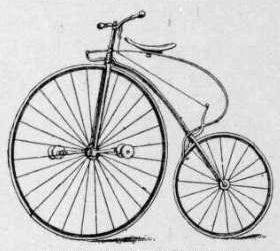
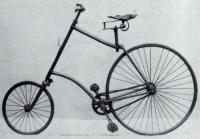
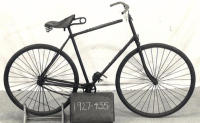


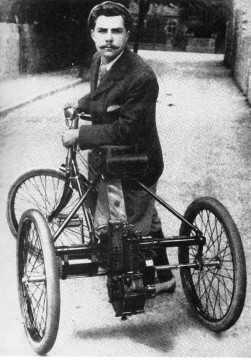
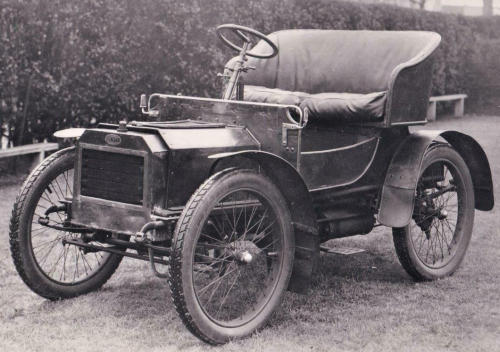

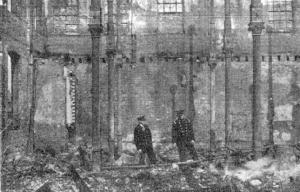 than they had at the previous fire, arrived on the scene and began to tackle the blaze which had already begun to spread. Below Jacksons was a storeroom used by A W Blacks for unused machines and the workrooms occupied by the Levers lace maker, W N Turner were adjacent
while an adjacent one-story building was occupied by the lace curtain maker, King & Co Ltd and all were soon engulfed by the blaze. Luckily, it did not spread to Black s main works which were just beyond. Jacksons, apparently the source of the blaze, was just next to
the clock o the Humber Road frontage and it was noticed that it had stopped with its hands stuck at 7.28 and the bell tower above it began to lean. Crowds assembled to watch the spectacle and the flames that lit up the sky could be seen for miles around.
than they had at the previous fire, arrived on the scene and began to tackle the blaze which had already begun to spread. Below Jacksons was a storeroom used by A W Blacks for unused machines and the workrooms occupied by the Levers lace maker, W N Turner were adjacent
while an adjacent one-story building was occupied by the lace curtain maker, King & Co Ltd and all were soon engulfed by the blaze. Luckily, it did not spread to Black s main works which were just beyond. Jacksons, apparently the source of the blaze, was just next to
the clock o the Humber Road frontage and it was noticed that it had stopped with its hands stuck at 7.28 and the bell tower above it began to lean. Crowds assembled to watch the spectacle and the flames that lit up the sky could be seen for miles around.